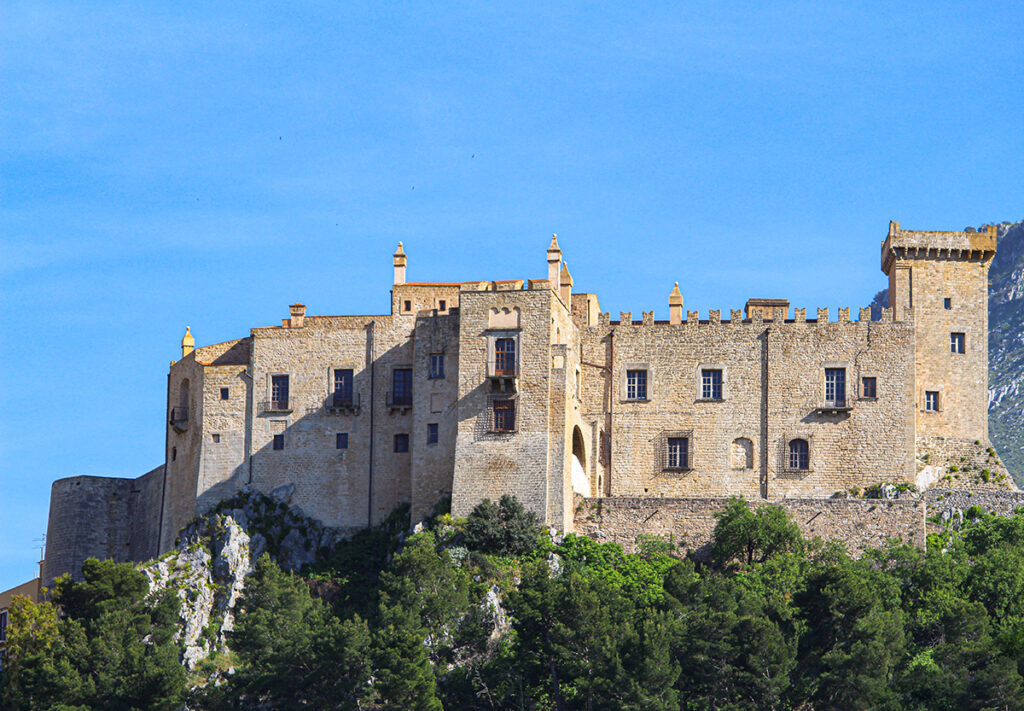Famous for the sad story of the Baroness of Carini, the La Grua Talamanca Castle has transformed over time from a military fortress to a noble residence: let’s discover its secrets
A medieval fortress that stands over all the surrounding territories and the sea, which later became a noble residence before being abandoned at the end of the feudal era. The Castle La Grua Talamanca in Carini is famous today for the sad story of the Baroness of Carini but its history is intertwined for over five hundred years with that of Sicily and tells of fallen nobles, lack of heirs as well as honor crimes.
The first traces of the Castle of Carini date back to the Arab period but historically the building was built in the Norman period, between the eleventh and twelfth centuries, by the feudal lord Rodolfo Bonello, a warrior who arrived in Sicily following Count Ruggiero I, conqueror of the island and first Count of Sicily starting in 1062. Its elevated position allowed the area to be controlled up to the coast to prevent attacks by pirates and enemies.
In 1238 the castle passed into the hands of the Abate family, who carried out the first works to transform it into a noble residence. The Abbots had to abandon the castle in 1397 at the behest of the King of Sicilia Martino I, who wanted to punish them, depriving them of all their assets, for having sided with the Chiaramonte family in the dispute for the crown.
Martin I granted the castle and the entire fiefdom of Carini to Ubertino La Grua who, however, had no male heirs and married his daughter Ilaria to the Catalan Gilberto Talamanca, giving life to the La Grua Talamanca family which remained in possession of the barony of Carini and the castle until 1812.

It is in the fourteenth century, during the dynasty of La Grua Talamanca, that the sad story of the Baroness of Carini took place. Laura Lanza di Trabia, daughter of Cesare Lanza, was married off at the age of just 14 years old to Vincenzo La Grua Talamanca. An arranged marriage, as was the custom of the time, to strengthen both families. Her husband was almost always absent and the baroness began to frequent the noble Ludovico Vernegallo, whose family owned the fiefdom of Montelepre. The two dated until Cesare Lanza discovered the secret love and, on the night of December 4, 1563, he broke into the castle together with his men to kill his daughter and lover. The man was acquitted and the truth was hidden. But a popular song (attributed by some to the poet Antonio Veneziano) has handed down the sad story of the Baroness of Carini to the present day. Legend has it that every year, on the anniversary of the crime, in the room where the baroness was killed, the imprint of a bloody hand appears on a wall.
In 1812, after the end of feudalism, the La Grua Talamanca family moved to France, abandoning the castle and leaving it to deteriorate until 1975 when, after the fall of the west wing, the heirs decided to donate it to the Municipality of Carini, which began restoration work.
Today the castle has an austere exterior, typical of the medieval period, with walls dating back to its first construction and Arab-Norman elements present on the second door, which features a pointed arch and the coat of arms of the Abbate family. Above the portals there are some shields with a crane, symbol of the La Grua family.
The internal appearance, in contrast to the external one, is much more colorful, typical of noble residences. The frescoed rooms present different styles, often overlapping, testifying to the embellishment works that have been carried out over the centuries to transform the fortress into an increasingly luxurious residence with light colors and pastel shades. Worthy of note is the fresco on the vault of the baroness’s room, which depicts Ulysses and Penelope.
The change of use of the building, from a guard fort to a noble residence, is also demonstrated by two inscriptions found on the first floor on two portals. One reads “Recedant Vetera” (Let the past be erased), the other “Et nova sint omnia” (And everything be renewed). They were probably placed during the works of the architect Matteo Carnalivari, in the second half of the 1400s.
On the ground floor you can see a wash house made of Billemi stone, a marble statue of the Madonna of Trapani and a frescoed chapel where you can admire a wooden tabernacle from the early 1600s with Corinthian columns.
On the upper floor there is the party room, which has a wooden coffered ceiling and a fireplace with the coat of arms of the La Grua family. From a side door it is possible to enter a room which legend has it was the one where the clandestine meetings between the Baroness of Carini and her lover took place.
And, in the end, everything returns to the Baroness of Carini, because her sad story and the legends that followed have created an aura of mystery around La Grua Talamanca Castle of Carini which attracts hundreds of tourists every year curious to see the apparition of the bloody hand or the ghost of the Baroness.





Comments are closed.